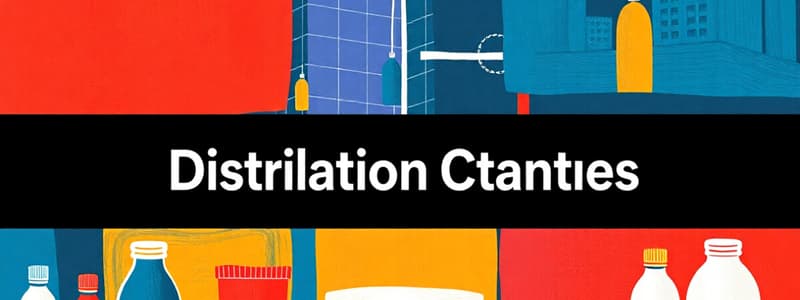Podcast
Questions and Answers
What is the function of wholesalers in a two-level channel?
What is the function of wholesalers in a two-level channel?
- Retailers buy directly from customers
- Agents facilitate market entry for goods
- Wholesalers buy large quantities and sell to retailers (correct)
- Manufacturers sell directly to customers
What is a three-level channel?
What is a three-level channel?
Manufacturer to Agent to Wholesaler to Retailer to Customer
A one-level channel involves retailers purchasing directly from manufacturers.
A one-level channel involves retailers purchasing directly from manufacturers.
True (A)
Which types of goods commonly use a direct channel?
Which types of goods commonly use a direct channel?
What is the role of distribution channels in marketing?
What is the role of distribution channels in marketing?
What does dual distribution refer to?
What does dual distribution refer to?
A distribution channel that connects the manufacturer directly to the customer is called a _____ channel.
A distribution channel that connects the manufacturer directly to the customer is called a _____ channel.
What is the primary role of agents in the distribution process?
What is the primary role of agents in the distribution process?
Flashcards are hidden until you start studying
Study Notes
Indirect Channels
- Two-level Channel: Manufacturer sells to wholesaler, who sells to retailer, who then sells to customer, suitable for inexpensive, standardized, durable goods with a broad market
- Three-level Channel: Manufacturer sells to agent, then to wholesaler, then to retailer, then to customer, suitable for nationwide products with high demand
- Agents: Facilitate faster market entry for goods after ordering
- Types of Agents:
- Super Stockiest: Purchase stock from manufacturers and sell it to wholesalers and retailers within their region
- Carrying and Forwarding Agents: Operate on a commission basis, providing services like warehousing, order processing, and last-mile delivery
Types of Distribution Channels
- Direct Channel (Zero-level Channel): The manufacturer sells directly to the customer without intermediaries, suitable for perishable, expensive goods, or goods with a concentrated target audience
- Example: Peddling, Brand retail Stores, Company Websites
- One-level Channel: The manufacturer sells to the retailer, who sells to the customer, suitable for shopping goods
- Indirect Channels: The manufacturer uses intermediaries to sell products to customers
Functions of Distribution Channels
- Facilitation: Offer pre-sale and post-purchase services like financing, maintenance, information dissemination, channel coordination
- Creating Efficiencies: Achieved through bulk breaking and creating assortments; wholesalers and retailers purchase large quantities, break them down, and sell to various channels or customers, and offer diverse products at a single location
- Sharing Risks: Intermediaries buy products beforehand, sharing risk with manufacturers, incentivizing sales
- Marketing: Intermediaries act as marketing channels, executing marketing strategies directly with customers, promoting brand message, product benefits, and services
- Types of Distribution Channels:
- Direct channel
- Indirect channels
Direct Sales
- Direct sales are a good distribution model for mid-range products that aren't purchased daily, like stationery, air purifiers, or jewelry.
- Direct distribution means the manufacturer communicates directly with customers, eliminating intermediaries.
- The Internet and e-commerce have popularized direct distribution.
- The key to successful direct distribution marketing is clear communication with the customer.
Strategies to Encourage Direct Sales
- Features: Emphasize product features and their purpose to capture customer attention.
- Advantages: Highlight the product's uniqueness compared to competitors and focus on its value proposition.
- Benefits: Explain how the product solves customer problems, saves time, or generates profit.
- Intimacy: Establish a personal connection with the customer, maintain their attention, and continually emphasize the value of the product.
- Reciprocity: Offer favors to the customer (e.g., free samples, discounts), making the favor feel exclusive. This subconscious feeling can influence a positive outcome for the product.
Dual Distribution
- A strategy where a manufacturer uses more than one marketing channel simultaneously to reach the end user.
Studying That Suits You
Use AI to generate personalized quizzes and flashcards to suit your learning preferences.




